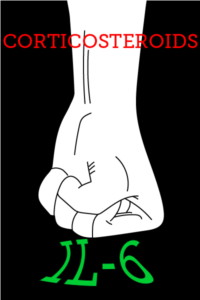A new study reports a surprisingly low rate of HHV-6 reactivation in recipients of half-matched bone marrow grafts using a reduced-intensity conditioning regimen. The authors speculate that the corticosteroid used for prophylaxis may have suppressed cytokine production which in turn limited reactivation of HHV-6.
The Japanese group found a low reactivation rate despite use of methylprednisolone and ATG (both of which have previously been identified as risk factors for HHV-6 reactivation). Although corticosteroids and ATG can increase the risk of HHV-6 reactivation, it may also be the case that they are preferable to cyclophosphamide, another immunosuppressant that has been associated with a higher incidence of HHV-6 reactivation in haplo-SCT recipients (Retière 2018), as GVHD prophylaxis. Another factor that may have contributed to the low reactivation rate included the type of graft, which was not manipulated and not cord blood.
Serum IL-6 was higher in the cord blood recipients and the 3 haplo-SCT recipients who had reactivated HHV-6 compared with those who did not. The investigators point out that a marked increase in serum IL-6 levels occurs in patients preceding HHV-6 reactivation (Ogata 2009), and the lower IL-6 levels seen in most of their patients may have prevented this viral reactivation.
In the stem cell transplantation setting, some protocols are associated with greater incidence and severity of HHV-6 reactivation. These risk factors include cord blood transplants, myeloablative conditioning, use of mycophenolate mofetil, and use of naive (CD45RA) T-cell–depleted grafts. A reduced-intensity conditioning regimen has been suggested as a reason behind low rates of HHV-6 encephalitis in a 2017 study (Illiaquer 2017), and has also been utilized in other studies with low rates of HHV-6 reactivation (Kato 2019, Dulery 2012).
 Among the HLA-haploidentical related stem cell transplant (haplo-SCT) patients in this study, only 3/42 (7.1%) patients were found to have HHV-6 DNA present in their plasma at >50 copies/mL. All three patients who reactivated had received myeloablative conditioning, while none of the 23 recipients of reduced-intensity conditioning experienced reactivation. Cord blood recipients, on the other hand, experience HHV-6 reactivation much more frequently, as expected- all of them had detectable HHV-6 DNA in plasma samples. Median peak viral load was also lower in the haplo-SCT group than the cord blood group (13,000 copies/mL vs 53,500 copies/mL). CMV antigenemia was observed at a high rate in the haplo-SCT recipients (85.7%), highlighting the difference in the activities of these related herpesviruses.
Among the HLA-haploidentical related stem cell transplant (haplo-SCT) patients in this study, only 3/42 (7.1%) patients were found to have HHV-6 DNA present in their plasma at >50 copies/mL. All three patients who reactivated had received myeloablative conditioning, while none of the 23 recipients of reduced-intensity conditioning experienced reactivation. Cord blood recipients, on the other hand, experience HHV-6 reactivation much more frequently, as expected- all of them had detectable HHV-6 DNA in plasma samples. Median peak viral load was also lower in the haplo-SCT group than the cord blood group (13,000 copies/mL vs 53,500 copies/mL). CMV antigenemia was observed at a high rate in the haplo-SCT recipients (85.7%), highlighting the difference in the activities of these related herpesviruses.
No HHV-6 encephalitis was observed in either group, possibly owing to the antiviral treatment, consisting of foscarnet or ganciclovir, which resulted in disappearance of plasma HHV-6 DNA.
A limiting factor of the study was the exclusion of patients who experienced rejection or died within 35 days after transplantation.
Find the full paper here: Tamaki 2019.

